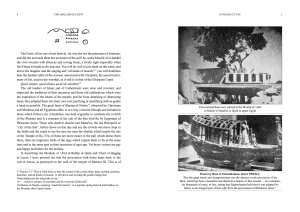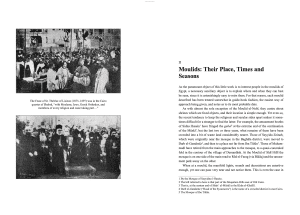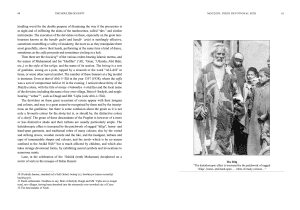Working to improve mutual understanding between the Middle East and the West
Working to improve mutual understanding between the Middle East and the West
No products in the basket.
Never reissued before, The Moulids of Egypt is a unique study of the popular Muslim and Christian festivals of Egypt and a modern classic of Egyptology
This book is a study of moulids, the popular Egyptian religious festivals (Muslim and Christian) as they were in the first half of the 20th century. Moulids also had a secular side, where sports, games, theatres, shadow- plays, beer booths, sweet stalls, eating houses, dancing, and laughter, were as much part of the festival as the religious processions and the whirling of dervishes. Nor were the festivals exclusive to one religion or the other— Muslims and Christians happily attended each other’s moulids.
Some of the rites and customs date from as far back as the Pharaonic period, but the moulids are gradually dying out. Many of the 126 festivals described here have since faded away, making the book of lasting interest.
Published in Cairo at the height of the Second World War, Bimbâshî McPherson’s The Moulids of Egypt is a fascinating and highly original contribution to the study of the country’s religious folklore and practice.
J. W. McPherson lived in Egypt for 45 years, working as a teacher before the First World War, then serving with the Red Cross at Gallipoli, as a soldier with the Egyptian Camel Transport in Sinai and Palestine, as an Intelligence Officer in Cairo, and until his retirement in 1924 as Ma’mûr Zapt, the Director of the political Criminal Investigation Department for investigating political activists and secret societies. In retirement, he researched the religious festivals called moulids and wrote this book.
Russell McGuirk was educated at Phillips Exeter Academy and Johns Hopkins University, where he studied Modern Languages, including Arabic. He went on to specialize in Middle Eastern Studies at Harvard University. The Moulids of Egypt is his fourth book as a specialist in Arabic and in early 20th century Egyptian history.
FOREWORD by PROFESSOR E. E. EVANS-PRITCHARD
M.A. (Oxon), Ph.D. (Lon), &c., Bimbashi,
List of MAPS
Illustrations
INTRODUCTORY
CHAPTER I Moulids, — Their Origin and Objects
(With genealogical tree of the Prophet’s family)
CHAPTER II “ — Their Place: their Times and Seasons
(With List of Moulids, assigned to fixed days of the week)
CHAPTER III “ — Their Devotional Side
CHAPTER IV “ — Their Secular Side
CHAPTER V “ — Their Individual Features
(With Calendar of approximate dates
Arabic and Coptic months
Sectional maps
Descriptive notes on one hundred and twenty-six Egyptian moulids (Christian and Islamic)
Envoi
Post Scriptum
Foreword to the New Edition
Published in 1941, J. W. McPherson’s The Moulids of Egypt is a rare gem of a book. A longtime resident of Egypt, McPherson became enamoured of Egypt’s moulids (saint’s day festivals), which are celebrated by both Muslims and Christians to honour holy men and women, especially those believed to be buried in Egypt, to seek their blessing and to enjoy the sociability of giving and receiving hospitality in the vicinity of their shrines. Although moulids take place in nearly every town and village in the country, this aspect of Egyptian life remains unknown to many, even some who live within a few streets of a major shrine. Fundamentalists attack the veneration of holy personages as blasphemy and modernists deem it superstition, but it is nonetheless an important part of the spiritual and social life of millions of people. As Biegman wrote, the moulids are in one sense “a world apart, which can easily be missed by those who find themselves in the top levels of society,” but in reality “it is the upper-crust and the foreigners who are the world apart, for what is described here is nothing short of a mass phenomenon.”1
McPherson wrote this book both as a plea for appreciation of the moulids and the secular festivities surrounding them, which were under frequent and sometimes violent attack by law enforcement at the time, and as a guidebook for those who would like to observe them. It is clear from his anecdotes that he enjoyed introducing members of the British expatriate community to these joyful celebrations. He writes of his personal experiences and observations in a lively, chatty style. In fact, one of the striking features of the book is its informality. For example, after speculating at some length on the likely similarity of the process of recognition of saints in Islam and Christianity, he notes that after writing those lines he was corrected on this point – but he does not remove the misleading
paragraphs from the book; he merely adds this correction to the conversation. McPherson also includes letters to newspaper editors that support his opposition to government suppression of the moulids, especially the secular entertainments that surround them. McPherson argues that piety is strengthened by these secular activities, not diminished.
In his foreword to the first edition of this book, E. E. Evans-Pritchard argued that the moulids are not only religious festivals but have important secular dimensions. The truth of this observation needs no debate; rather, it has become necessary to insist that moulids serve religious purposes. When I gave a lecture on the moulids at the American Research Center in Egypt in 1988, an Egyptian history professor in the audience denied that the moulids have any religious significance at all. Therefore, I feel it is important to emphasize the centrality for Egyptian Sufism of devotion to the Prophet Muhammad, members of his family who are thought to be buried in Egypt, and other saintly figures. When I conducted field- work among the Sufis in Egypt in 1987–1989, I often asked them to define Sufism. Most often, they said it is the purification of the soul, genuine love for God, or the very essence of Islam. But one old man’s response clarifies how many practitioners understand the method by which these are attained. We were conversing during the moulid of the Prophet’s great-granddaughter, Fâtima -l-Nebawîya. The man was head of a group of Sufis that, like many others, had erected a pavilion in the vicinity of the shrine, offering hospitality to passersby. Sufis camp out in these pavilions for an entire week or more. He said:
Sufism means love for the family of the Prophet. The Prophet is our intercessor and the one who brings us close to God, and it is through his family that we come close to him. […] It is love for the family of the Prophet that causes us to be purified. This is why we come to the shrines of the family of the Prophet. […] Why else would I leave my comfortable bed and come sleep on the pavement? I wouldn’t be able to sleep on the pavement if it weren’t for my love for the Prophet and his family. It is this love that purifies us and brings us close to God. That is why we do dhikr2 here. That is why we come here to serve people.3
This response makes clear that for him and many other Sufis, attendance at moulids is not only for blessing, entertainment, or sociability; it is a main focus of their spiritual development and service. For this reason, the lives of many devotees revolve around traveling the circuit of moulids. Moulids serve as occasions for members of different Sufi groups to meet and network and, because they are also popular festivals that attract large masses of people, they offer a venue for the orders to attract new members. Despite the wealth of information and detail contained in McPherson’s book, these aspects of the function of moulids in Sufi life appear to have largely escaped the author’s notice.
McPherson provides helpful hand-drawn maps to help visitors locate the shrines where the moulids are held. He also provides as much information as he can about when the moulids are held, although, as he points out, the dates are rarely exactly the same from one year to the next. The usefulness of McPher- son’s book as a guide to the moulids is limited by the fact that street names and the means of public transport, which he meticulously notes for each shrine, are subject to change, and the celebrations themselves are subject to change. Some of the moulids McPherson describes no longer take place. He even notes one moulid that he went to one year but was gone the next, the shrine destroyed and the body of the saint exhumed. On the other hand, some moulids, such as those of Ahmed el-Rifâ‘î and Sayyida Nafîsa, which McPherson described as nearly extinct, are once again major celebrations. The impact on the moulid landscape of the Egyp- tian government’s recent removal of thousands of tombs and historical monu- ments around the shrines of Sayyida ‘Aysha and Sayyida Nafîsa remains to be seen, but it is likely to be considerable.4 Those who are interested in seeing some of the activities McPherson describes but whose visit to Egypt does not coincide with a moulid may be interested in observing zikr at a shrine that has a weekly observance. Zikr after the afternoon and evening prayers may be observed at the following shrines: Sayyida Nafîsa on Sundays, Fâtima -l-Nebawîya on Mondays, Husein and Sayyida Zeinab on Fridays, and ‘Alî Zein el-ʿAbdîn on Saturdays.
McPherson describes a number of incidents of sometimes violent police suppression of moulids. These days, devotees face an even more pernicious threat. In March 2011, following the resignation of former President Hosni Mubarak, there were simultaneous, coordinated attacks on Sufi shrines in several cities, allegedly perpetrated by Salafis,5 though some cast doubt on Salafi culpability.6 Sufi responses included protest marches and calls for ordinary citizens to form committees to guard the shrines.7 The sheikh of the ‘Azmîya order warned of a civil war “beyond imagination, should the destruction of shrines persist.”8 Lest we think that the government is antagonistic to Sufism, it is noteworthy that the two leading representatives of the Islamic religious establishment in Egypt at the time, the Sheikh of Al-Azhar and the Mufti of Egypt, were Sufis who roundly denounced the attacks. McPherson notes the inconsistency of the government’s policy toward moulids, and that inconsistency remains today. Moulids can only be held with government permission, which is sometimes withheld for various reasons. In separate incidents, I and at least two other colleagues were prevented by police from taking photographs or recording videos at saints’ shrines, especially during moulids, although enforcement of such a ban (which is not official) is inconsistent. A policeman told me that the government does not want such images to be seen overseas. Long years of unjust Western criticism of Muslim societies as lacking in rationality have prompted Muslim governments to promote an image of Islam as a religion of reason, not of the sort of passion, ardent devotion and fun that are seen at the moulids. But the vigilance of law enforcement at moulids is now focused more on the potential for violent attacks on the celebrations than on preventing the festivities.
Although there are academic works on the moulids9 and Biegman’s wonderful book of photographs, there is no book other than McPherson’s that can serve as a guide for those who wish to observe a moulid. The book also serves as an artifact of a not-too-distant past. A contemporary reader of McPherson’s book cannot help but be struck by the number of languages the author assumes the reader will understand, including Latin, Italian, French, and German. He also frequently invokes literary sources that might not be well known to contemporary readers. Today’s readers will be grateful for Russell McGuirk’s footnotes, which clarify these citations. No commentary is needed to appreciate McPherson’s vivid descriptions, which take us into the world of traditional Egyptian piety, sociability, and joy.
Valerie J. Hoffman
University of Illinois Urbana-Champaign, USA 20 March 2022
1 Nicolaas H. Biegman, Egypt: Moulids, Saints, Sufis (London: Kegan Paul; The Hague: SDU Publishers, 1990), p. 8.
2 Dhikr, or zikr in its Egyptian pronunciation, is the “remembrance” of God through repetition of His “beautiful names” (el-asmâ’ el-husnâ). McPherson explains its practice in Chapter 3.
3 Valerie J. Hoffman-Ladd, “Devotion to the Prophet and His Family in Egyptian Sufism,” International Journal of Middle East Studies 24 (1992): 615–637 (quotation on pp. 617–618); Valerie J. Hoffman, Sufism, Mystics, and Saints in Modern Egypt (Columbia, South Carolina: University of South Carolina Press, 1995), pp. 50–88 (quotation on pp. 81–82).
4 In January 2021, the Egyptian government announced that 2760 tombs, 360 families, and 23 shops in the area of the Sayyida ‘Aysha shrine would be removed as part of its development of the area. The families would be moved to the Asmarât housing project in Muqaṭṭam (Egypt Today, 12 January 2021); the shops to the Tûnisî market; and the tombs would be removed to the 15th of May City in eastern Helwan (Nawâfidh, 30 January 2021). Likewise, in November 2021, the government removed some of the tombs in the area of the shrine of Sayyida Nafîsa in order to build a new bridge, arousing the ire of many people, including engineers, contractors, experts in the historical monuments of the area, and families whose members were buried in the targeted tombs (Mubâshir Al Jazeera, 18 November 2021).
5 Mohammed Abdel Khaliq, “Salafi attacks on Sufi shrines violate Islam, declares Grand Imam of Al Azhar Al Sharif,” Al-Ahram Daily, 4 April 2011; Injy El-Kashef, “The Shrine Affair,” Al-Ahram Weekly, 7–13 April 2011; “Religious Endowments Ministry to Confront Extremist Attacks,” Egypt Independent, 7 April 2011. The term salafi, which means following the ways of the early Muslims, was first used of modernist reformists in the early twentieth century, but in the last few decades it has come to denote Muslim fundamentalists, who aim to eradicate all practices that they regard as religiously illegitimate.
6 Jonathan Brown, “Salafis and Sufis in Egypt” (Washington, DC: Carnegie Endowment for International Peace, December 2011), 8, 10.
7 “Egypt’s Sufis to Form Popular Committees for Self-Defence,” Ahram Online, 1 April 2013; El-Kashef, “The Shrine Affair.”
8 Ibid.
9 A fairly recent study is Samuli Schielke, The Perils of Joy: Contesting Mulid Festivals in Contemporary Egypt (Syracuse, NY: Syracuse University Press, 2012).



‘An invaluable work…a superb first-hand glimpse of the life of Egypt’
—Lawrence Durrell
‘It is a masterpiece and was invaluable to me when writing “The Pharaoh’s Shadow”.’
—Anthony Sattin
‘A contribution to our knowledge of Egyptian life, a worthy supplement to the immortal writings of Lane … McPherson has paid to the people of Egypt the debt which he freely acknowledges he owes them for the hospitality and kindness he has enjoyed at their hands for close on half a century.’
–From the 1941 foreword by E. E. Evans-Pritchard